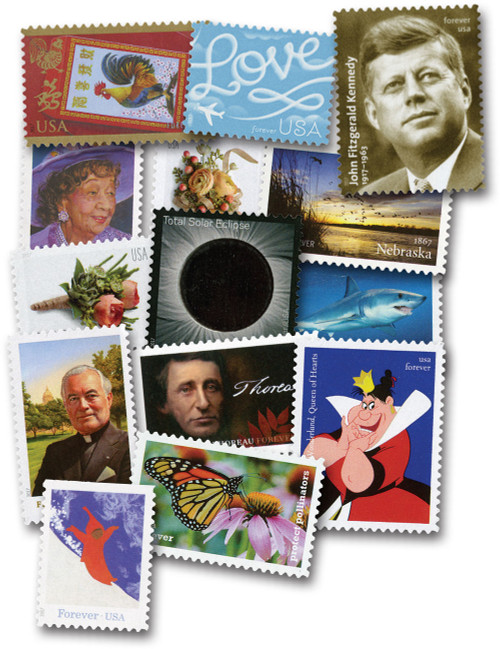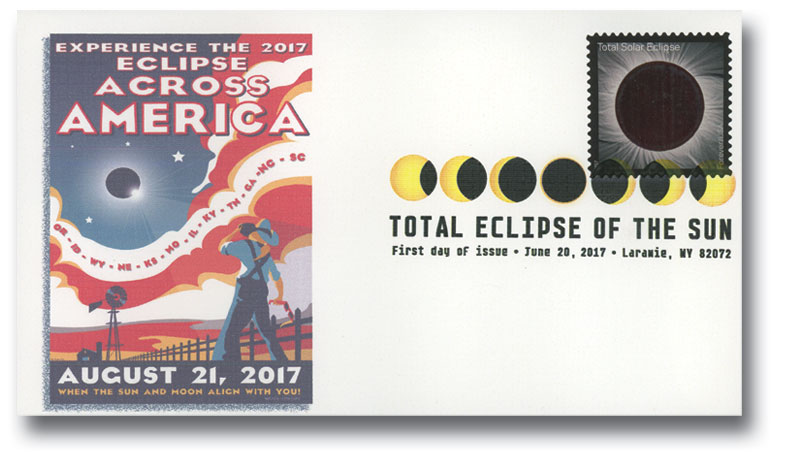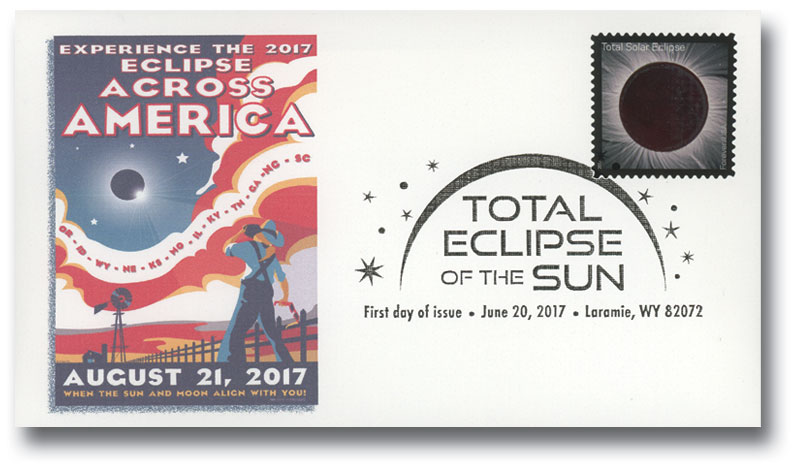
# 5211 - 2017 First-Class Forever Stamp - Total Solar Eclipse
#1 Most Popular Stamp of 2017 As Voted by Stamp Collectors
August 21, 2017, marks the first total solar eclipse to cross both U.S. coasts since 1918. It is also the first time since 1257 a total solar eclipse can be viewed only from within the continental United States. Because of their rarity, many people often host parties and educational events to watch a total eclipse.
Looking directly into the sun at any time can cause permanent damage to the human eye. For this reason eclipse glasses must be worn to watch the event. These lenses protect the retina with specially designed filters that block harmful solar rays, something normal sunglasses cannot do. Telescopes and cameras should also have solar filters attached to prevent possible damage to sensors and other equipment.
Printed by: Banknote Corporation of America
Method: Offset
Self-Adhesive
First Heat-Sensitive Stamp

On June 20, 2017, the USPS issued the first-ever heat sensitive stamp, honoring the total solar eclipse that occurred later that year.
The stamp marked the first time the USPS used thermochromic ink. When heat is applied (from your thumb for example), the thermochromic ink disappears, revealing the photo of the Moon underneath. And once the ink cools, the black disc replicating the effect of the eclipse, returns.

The stamp was issued on June 20, 2017, at the Art Museum of the University of Wyoming during their summer solstice celebration. Prior to the stamp issue ceremony, they hosted an event for visitors to showcase one of the museum’s features. At noon on the summer solstice, the sunlight passes through a hole in the building and shines on a silver dollar inserted into the floor.
The back of the stamp pictures a map of the eclipse, including the approximate times it would be visible in certain locations along its path. It should be noted that the thermochromic ink is sensitive to UV light and should be kept out of direct sunlight as much as possible to preserve the effect. This stamp was voted the #1 most popular issue of 2017 by collectors.
A total solar eclipse is a phenomenon that occurs when the moon passes between Earth and the sun, completely blocking its light for several minutes. As the moon continues its orbit, different areas of the Earth experience totality (full coverage of the sun) at different times. Some may only see a partial eclipse while others may not see an eclipse at all.
#1 Most Popular Stamp of 2017 As Voted by Stamp Collectors
August 21, 2017, marks the first total solar eclipse to cross both U.S. coasts since 1918. It is also the first time since 1257 a total solar eclipse can be viewed only from within the continental United States. Because of their rarity, many people often host parties and educational events to watch a total eclipse.
Looking directly into the sun at any time can cause permanent damage to the human eye. For this reason eclipse glasses must be worn to watch the event. These lenses protect the retina with specially designed filters that block harmful solar rays, something normal sunglasses cannot do. Telescopes and cameras should also have solar filters attached to prevent possible damage to sensors and other equipment.
Printed by: Banknote Corporation of America
Method: Offset
Self-Adhesive
First Heat-Sensitive Stamp

On June 20, 2017, the USPS issued the first-ever heat sensitive stamp, honoring the total solar eclipse that occurred later that year.
The stamp marked the first time the USPS used thermochromic ink. When heat is applied (from your thumb for example), the thermochromic ink disappears, revealing the photo of the Moon underneath. And once the ink cools, the black disc replicating the effect of the eclipse, returns.

The stamp was issued on June 20, 2017, at the Art Museum of the University of Wyoming during their summer solstice celebration. Prior to the stamp issue ceremony, they hosted an event for visitors to showcase one of the museum’s features. At noon on the summer solstice, the sunlight passes through a hole in the building and shines on a silver dollar inserted into the floor.
The back of the stamp pictures a map of the eclipse, including the approximate times it would be visible in certain locations along its path. It should be noted that the thermochromic ink is sensitive to UV light and should be kept out of direct sunlight as much as possible to preserve the effect. This stamp was voted the #1 most popular issue of 2017 by collectors.
A total solar eclipse is a phenomenon that occurs when the moon passes between Earth and the sun, completely blocking its light for several minutes. As the moon continues its orbit, different areas of the Earth experience totality (full coverage of the sun) at different times. Some may only see a partial eclipse while others may not see an eclipse at all.









